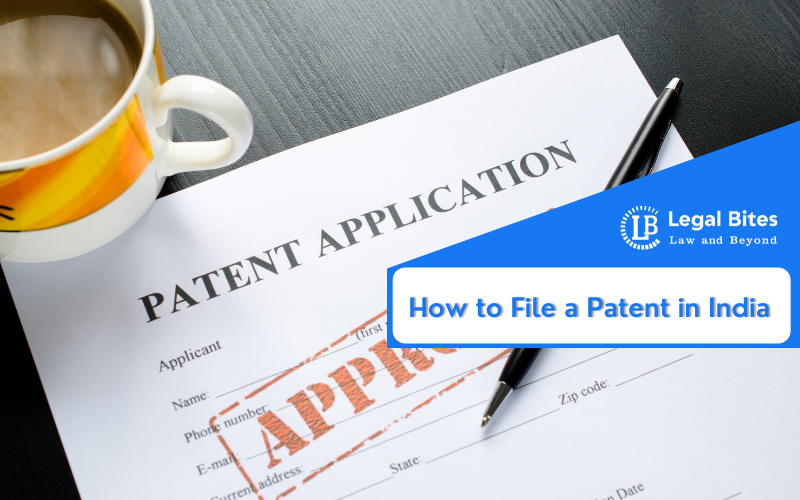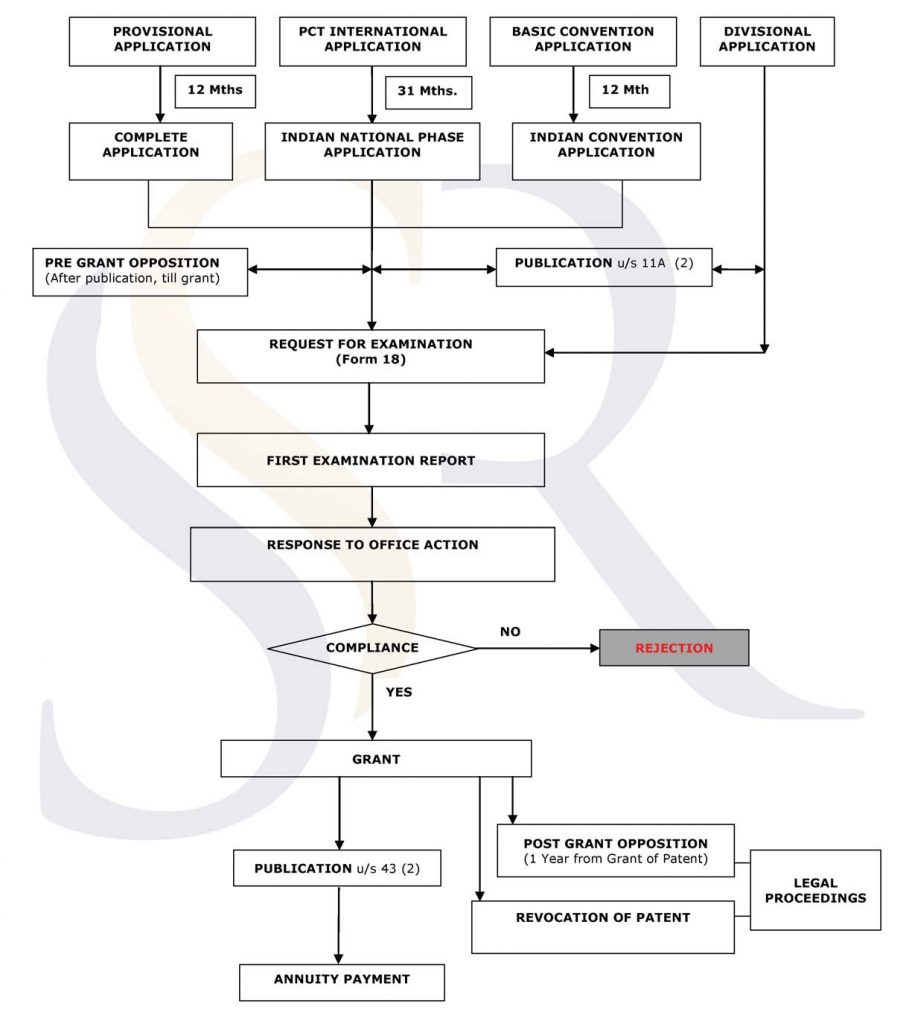How to File a Patent in India
Patents should be obtained in each country where the applicant requires the protection of his invention. Learn How to File a Patent in India. I. Introduction A patent is a set of exclusive rights granted by a sovereign state or intergovernmental organization to an inventor or assignee for a limited period of time (the terms and conditions might… Read More »

Patents should be obtained in each country where the applicant requires the protection of his invention. Learn How to File a Patent in India.
I. Introduction
A patent is a set of exclusive rights granted by a sovereign state or intergovernmental organization to an inventor or assignee for a limited period of time (the terms and conditions might vary from place to place) and is included in the category of Intellectual Property Rights.
Patents have a very old history, but the current system regarding the same is what started around the 19th century. The era of globalization and the increasing significance of international organization thereof have considerably affected the form that it exists in, today, and is continuously undergoing changes.
II. Patent in India: Background
The first legislation in India relating to patents was Act VI of 1856 (on the lines of the United Kingdom Act of 1852 ) with the objective to encourage inventions of new and useful manufactures and to induce inventors to disclose the secret of their inventions. After several amendments & repeals, before and after Independence the present patent law of India stands as the Patents Act, 1970, this too underwent various amendments so as to make it more comprehensive, and conducive to the national interest, the last one being the Patents (Amendment) Act 2005.
In addition to the Patents Act, 1970, there are Patent Rules which guide the patents system in India, which after amendments stand as Patents (Amendment) Rules, 2016.
[For complete history check here]
In addition, it has to be noted that patent protection is a territorial right and therefore it is effective only within the territory of India. There is no concept of a global patent. However, filing an application in India enables the applicant to file a corresponding application for the same invention in convention (Paris Convention, 1883) countries or under PCT (Patent Cooperation Treaty, 1970), within or before the expiry of twelve months from the filing date in India. Patents should be obtained in each country where the applicant requires the protection of his invention.
III. Type of Applications
Considering that the invention qualifies for a patent (under the related law), these are the possible ways for the application of the right –
Provisional Application
Indian Patent Law follows the first to file system. A provisional application is an application that can be filed if the invention is still under the experimentation stage. Filing a provisional specification provides an advantage to the inventor since it helps in establishing a ―priority date of the invention. Further, the inventor gets 12 months‘ time to fully develop the invention and ascertain its market potential and file the complete specification.
Ordinary Application
An application for patent filed in the Patent Office without claiming any priority either in a convention country or without any reference to any other earlier application under process in the office. Such a type of application is known as an ordinary application.
Conventional Application
An application for a patent filed in the Patent Office, claiming a priority date based on the same or substantially similar application filed in one or more of the convention countries is known as a convention application. In order to get convention status, an applicant should file the application in the Indian Patent Office within 12 months from the date of the first filing of a similar application in the convention country.
PCT International Application
An Application filed in India as Receiving Office (RO) under Patent Cooperation Treaty is an international application that can be filed in more than 150 countries by a single application.
PCT National Phase Application
When an international application is made according to PCT designating India, an applicant can file the national phase application in India within 31 months from the international filing date or the priority date, whichever is earlier.
IV. How to File a Patent in India – Procedure
So it is quite apparent that no matter what route you take, you have to apply for the national patent, now or later. The procedure for application in India goes thus as follows:
Online
One can file patent applications through a comprehensive online filing system available here. To register for the filing of a patent application, the user is required to obtain the Class III digital signature. After obtaining the digital signature, the user can register himself on the CGPDTM(Controller General of Patent, Trademark and Design) website by creating his user ID and password. The digital signatures can be obtained from the certifying authorities such as (n)Code solutions, TCS and SAFESCRIPT or eMudra.
The following are the e-filing facilities available for an applicant:
- Comprehensive e-filing facility for Patents and Designs,
- Comprehensive payment gateway including net banking, payment by Debit/Credit card
- Web-based Simple Registration process and filing procedure
- Real-time Validations with IPO Patent database
- Manage User Profile and Folders
- 10% fee reduction on online filing compared to offline filing to promote online filing.
- Request for expedited examination- only through e-filing
Offline
A patent application can be filed with Indian Patent Office either with the provisional specification or with complete specification along with fee as prescribed in schedule I. In case the application is filed with the provisional specification, then one has to file a complete specification within 12 months from the date of filing of the provisional application. There is no further extension of time to file complete specifications after the expiry of the said period.
India has four patent offices located at Kolkata, New Delhi, Mumbai and Chennai.
Each office has a separate territorial jurisdiction. The appropriate office for all proceedings including the filing of the application depends normally on where the applicant/first mentioned applicant resides/has domicile/has the place of business/has the origin of the invention. In the case of foreign applicants, it depends on the address for service in India given by such applicant.
Generally, in order to file an application, an applicant is required to file Form 1 which is a request for filing an application and Form 2 which is either a provisional or complete specification or drawings if any. In addition to these, an abstract of the invention is also required. If the application is filed through a registered patent agent, a power of authority in favour of the said agent in Form 26 is also required. However, depending upon various circumstances, various other forms may also be required. The details of the same are :
- Form 1 – Application for Grant of Patent
Contains legal information such as name, contact details of the applicant, inventors, priority date etc. To be accompanied by provisional or complete specification(Form 2).
- Form 2
Contains invention including title, field, background prior art , drawbacks of the known inventions, description, experimental results, drawings, abstract of the invention etc. Claims in the complete specification are legal boundaries of the invention.
- Form 3 – Statement and undertakings foreign applications
Information regarding the details of the invention if filed abroad and the undertaking to inform the patent office as and when he files the same abroad.
- Form 5 – Declaration as to inventorship
The application discloses the name of all the inventors. This is generally used when the complete specification is filed.
- Form 18 – Request for examination of a patent application
This form can be filed anytime within 48 months of filing an application. It can be filed even at the time of filing the patent application. Without the filing of this form, the patent specification will not be examined.
- Form 18A – Request for expedited examination of a patent application can be filed if
The applicant indicates India as the competent International searching authority or elects India as an International Preliminary Examining Authority in the corresponding international application, or the applicant is a start-up.
- Form 26 – Form of authorization of a Patent Agent
This form is required when the applicant is authorizing a patent agent to act on his/her behalf.
- Form 9
This form is required to be filed if the applicant wants that application is published before 18 months of filing.

Note– This is a general filing procedure, various exceptions, grants, and additional requirements have been specified for some specific categories of inventions and setups.
Sources:
- www.ipindia.nic.in
- www.hg.org
- www.wipo.in

